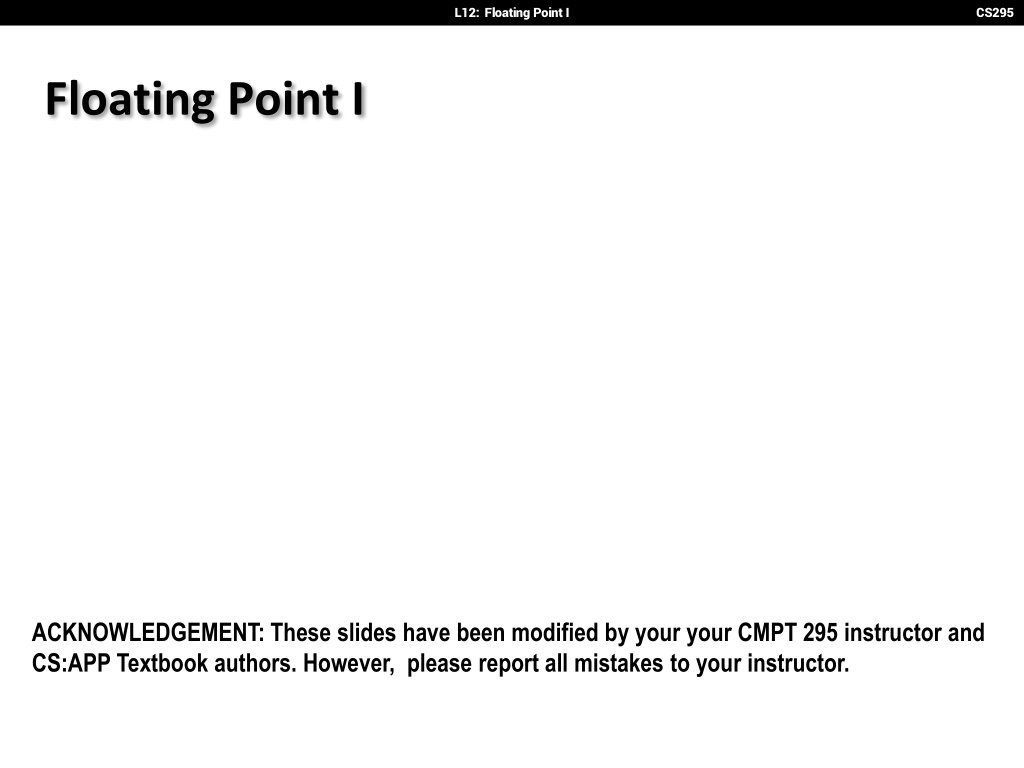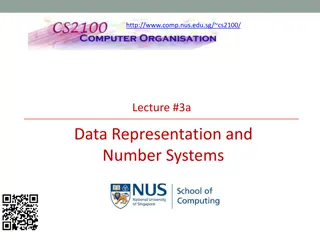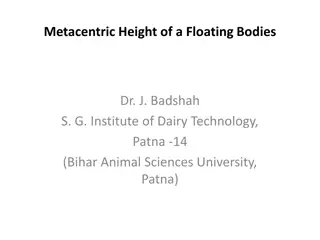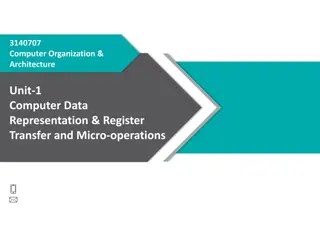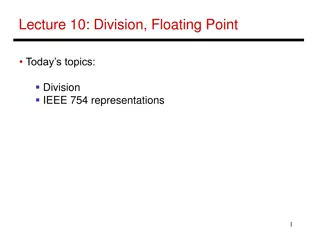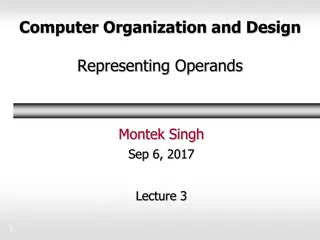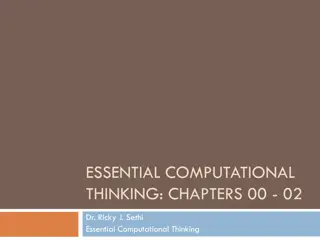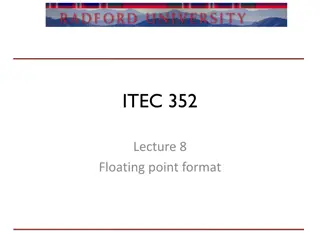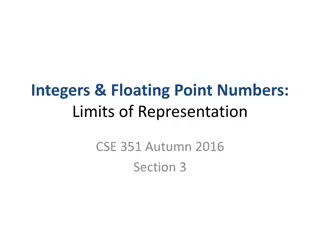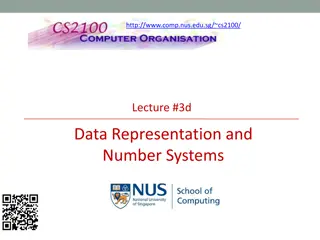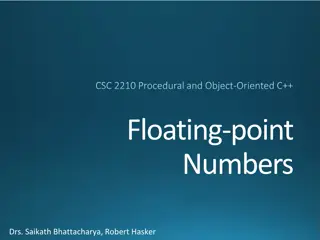Understanding Floating Point Representation in Computer Science
Explore the significance of number representation in computer systems, from integers to real numbers and special cases like NaN. Delve into past incidents where flaws in floating-point representation led to costly errors, emphasizing the importance of precision and accuracy in computing. Learn about fractional binary numbers, IEEE floating-point standards, and the complexities of floating-point operations in C.
Download Presentation

Please find below an Image/Link to download the presentation.
The content on the website is provided AS IS for your information and personal use only. It may not be sold, licensed, or shared on other websites without obtaining consent from the author. Download presentation by click this link. If you encounter any issues during the download, it is possible that the publisher has removed the file from their server.
E N D
Presentation Transcript
L12: Floating Point I CS295 Floating Point I ACKNOWLEDGEMENT: These slides have been modified by your your CMPT 295 instructor and CS:APP Textbook authors. However, please report all mistakes to your instructor.
L12: Floating Point I CS295 Number Representation Revisited What can we represent in one word? Signed and Unsigned Integers Characters (ASCII) Addresses How do we encode the following: Real numbers (e.g. 3.14159) Very large numbers (e.g. 6.02 1023) Very small numbers (e.g. 6.626 10-34) Special numbers (e.g. , NaN) Floating Point 2
L12: Floating Point I CS295 Number Representation Really Matters 1991: Patriot missile targeting error clock skew due to conversion from integer to floating point 1996: Ariane 5 rocket exploded ($1 billion) overflow converting 64-bit floating point to 16-bit integer 2000: Y2K problem limited (decimal) representation: overflow, wrap-around 2038: Unix epoch rollover Unix epoch = seconds since 12am, January 1, 1970 signed 32-bit integer representation rolls over to TMin in 2038 Other related bugs: 1982: Vancouver Stock Exchange 10% error in less than 2 years 1994: Intel Pentium FDIV (floating point division) HW bug ($475 million) 1997: USS Yorktown smart warship stranded: divide by zero 1998: Mars Climate Orbiter crashed: unit mismatch ($193 million) 3
L12: Floating Point I CS295 Floating Point Topics Fractional binary numbers IEEE floating-point standard Floating-point operations and rounding Floating-point in C There are many more details that we won t cover It s a 58-page standard 4
L12: Floating Point I CS295 Representation of Fractions Binary Point, like decimal point, signifies boundary between integer and fractional parts: xx.yyyy Example 6-bit representation: 21 2-4 20 2-1 2-22-3 Example:10.10102 = 1 21 + 1 2-1 + 1 2-3 = 2.62510 5
L12: Floating Point I CS295 Representation of Fractions Binary Point, like decimal point, signifies boundary between integer and fractional parts: xx.yyyy Example 6-bit representation: 21 2-4 20 2-1 2-22-3 In this 6-bit representation: What is the encoding and value of the smallest (most negative) number? What is the encoding and value of the largest (most positive) number? What is the smallest number greater than 2 that we can represent? 6
L12: Floating Point I CS295 Scientific Notation (Decimal) mantissa exponent 6.0210 1023 radix (base) decimal point Normalized form: exactly one digit (non-zero) to left of decimal point Alternatives to representing 1/1,000,000,000 Normalized: Not normalized: 1.0 10-9 0.1 10-8,10.0 10-10 7
L12: Floating Point I CS295 Scientific Notation (Binary) mantissa exponent 1.012 2-1 radix (base) binary point Computer arithmetic that supports this called floating point due to the floating of the binary point Declare such variable in C as float (or double) 8
L12: Floating Point I CS295 Translating To and From Scientific Notation Consider the number 1.011two 24 To convert to ordinary number, shift the decimal to the right by 4 Result: 10110two = 22ten For negative exponents, shift decimal to the left 1.011two 2-2 => 0.01011two =0.34375ten Go from ordinary number to scientific notation by shifting until in normalized form 1101.001two => 1.101001two 23 9
L12: Floating Point I CS295 Father of Floating Point Standard IEEE Standard 754 for Binary Floating- PointArithmetic 1989 ACM Turing Award Winner! Prof. Kahan Prof. Emeritus UC Berkeley www.cs.berkeley.edu/~wkahan/ieee754status/754story.html
L12: Floating Point I CS295 Floating Point Topics Fractional binary numbers IEEE floating-point standard Floating-point operations and rounding Floating-point in C There are many more details that we won t cover It s a 58-page standard 12
L12: Floating Point I CS295 IEEE Floating Point IEEE 754 Established in 1985 as uniform standard for floating point arithmetic Main idea: make numerically sensitive programs portable Specifies two things: representation and result of floating operations Now supported by all major CPUs Driven by numerical concerns Scientists/numerical analysts want them to be as real as possible Engineers want them to be easy to implement and fast In the end: Scientists mostly won out Nice standards for rounding, overflow, underflow, but... Hard to make fast in hardware Float operations can be an order of magnitude slower than integer ops 13
L12: Floating Point I CS295 Floating Point Encoding Use normalized, base 2 scientific notation: Value: 1 Mantissa 2Exponent Bit Fields: (-1)S 1.M 2(E bias) Representation Scheme: Sign bit (0 is positive, 1 is negative) Mantissa (a.k.a. significand) is the fractional part of the number in normalized form and encoded in bit vector M Exponent weights the value by a (possibly negative) power of 2 and encoded in the bit vector E 31 30 23 22 0 S E M 1 bit 8 bits 23 bits 14
L12: Floating Point I CS295 The ExponentField Why use biased notation for the exponent? Remember that we want floating point numbers to look small when their actual value is small We don t like how in 2 s complement, -1 looks bigger than 0. Bias notation preserves the linearity of value 31 30 23 22 0 S Exponent 8 bits Significand 23 bits 1 bit 15
L12: Floating Point I CS295 The Exponent Field Use biased notation Read exponent as unsigned, but with bias of 2w-1-1 = 127 Representable exponents roughly positive and negative Exponent 0 (Exp = 0) is represented as E = 0b 0111 1111 Why biased? Makes floating point arithmetic easier Makes somewhat compatible with two s complement Practice: To encode in biased notation, add the bias then encode in unsigned: Exp = 1 E = 0b Exp = 127 E = 0b Exp = -63 E = 0b 16
L12: Floating Point I CS295 The Mantissa (Fraction) Field 31 30 23 22 0 S E M 1 bit 8 bits 23 bits (-1)S x (1 . M) x 2(E bias) Note the implicit 1 in front of the M bit vector Example: 0b 0011 1111 1100 0000 0000 0000 0000 0000 is read as 1.12 = 1.510, not 0.12 = 0.510 Gives us an extra bit of precision Mantissa limits Low values near M = 0b0 0 are close to 2Exp High values near M = 0b1 1 are close to 2Exp+1 17
L12: Floating Point I CS295 Peer Instruction Question What is the correct value encoded by the following floating point number? 0b 0 10000000 11000000000000000000000 A. + 0.75 B. + 1.5 C. + 2.75 D. + 3.5 E. We re lost 18
L12: Floating Point I CS295 Precision and Accuracy Precision is a count of the number of bits in a computer word used to represent a value Capacity for accuracy Accuracy is a measure of the difference between the actual value of a number and its computer representation High precision permits high accuracy but doesn t guarantee it. It is possible to have high precision but low accuracy. Example:float pi = 3.14; pi will be represented using all 24 bits of the mantissa (highly precise), but is only an approximation (not accurate) 19
L12: Floating Point I CS295 Need Greater Precision? Double Precision (vs. Single Precision) in 64 bits 63 62 52 51 32 S 31 E (11) M (20 of 52) 0 M (32 of 52) C variable declared as double Exponent bias is now 210 1 = 1023 Advantages: Disadvantages: more bits used, greater precision (larger mantissa), greater range (larger exponent) slower to manipulate 20
L12: Floating Point I CS295 Floating Point Numbers Summary Exponent 0 0 1-254 255 255 Significand ? ? anything ? ? Meaning ? ? fl. pt ? ? 21
L12: Floating Point I CS295 RepresentingZero But wait what happened to zero? Using standard encoding 0x00000000 is 1.0 2-127 0 All because of that dang implicit 1 Special case: Exp and Significand all zeros = 0 Two zeros! But at least 0x00000000 = 0 likeintegers 31 30 23 22 0 +0 0 00000000 sign exponent 31 30 00000000000000000000000 significand 23 22 0 -0 1 00000000 sign exponent 00000000000000000000000 significand 22
L12: Floating Point I CS295 Floating Point Numbers Summary Exponent 0 0 1-254 255 255 Significand 0 ? anything ? ? Meaning 0 ? fl. pt ? ? 23
L12: Floating Point I CS295 Representing Division by zero infinity is a number! okay to do further comparison eg. x/0 > y Representation Max exponent = 255 all zero significand 31 30 2322 0 + 0 11111111 sign exponent 31 30 00000000000000000000000 significand 2322 0 - 1 11111111 sign exponent 00000000000000000000000 significand 24
L12: Floating Point I CS295 Floating Point Numbers Summary Exponent 0 0 1-254 255 255 Significand 0 non-zero anything 0 non-zero Meaning 0 ? fl. pt ? 25
L12: Floating Point I CS295 RepresentingNaN 0/0, sqrt(-4), ? Useful for debugging Op(NaN, some number) = NaN Representation Max exponent = 255 non-zero significand 31 30 2322 0 + NaN 0 11111111 sign exponent 31 30 Non-zero significand 2322 0 - NaN 1 11111111 sign exponent Non-zero significand 26
L12: Floating Point I CS295 Floating Point Numbers Summary Exponent 0 0 1-254 255 255 Significand 0 non-zero anything 0 non-zero Meaning 0 ? Norm fl. pt NaN 27
L12: Floating Point I CS295 Representing Very Small Numbers But wait what happened to zero? Using standard encoding 0x00000000 = Special case: E and M all zeros = 0 Two zeros! But at least 0x00000000 = 0 like integers b Gaps! New numbers closest to 0: a = 1.0 02 2-126 = 2-126 b = 1.0 012 2-126 = 2-126 + 2-149 Normalization and implicit 1 are to blame Special case: E = 0, M 0 are denormalized numbers + - 0 a 28
L12: Floating Point I CS295 Denorm Numbers Short for denormalizednumbers No leading1 Careful! Implicit exponent = -126 when Exp = 0x00 (intuitive reason: the binary point moves one more bit to the left of the leading bit) Now what do the gaps looklike? Smallest denorm: 0.0 01two 2-126 = 2-149 Largest denorm: 0.1 1two 2-126 = (2-126 2-149) Smallest norm: 1.0 0two 2-126 = 2-126 So much closer to0 29 No uneven gap! Increments by2-149
L12: Floating Point I CS295 Floating Point Numbers Summary Exponent 0 0 1-254 255 255 Significand 0 non-zero anything 0 non-zero Meaning 0 Denorm flpt. Norm fl. pt NaN 30
L12: Floating Point I CS295 Converting From Hex and Decimal Convert 0x40600000 to decimal 1 bit for sign, 8 bits for exponent, 23 bits for significand, bias of -127
L12: Floating Point I CS295 Step 1: Convert toBinary 0x40600000 = 0100 0000 0110 0000 0000 0000 0000 0000
L12: Floating Point I CS295 Step 2: Split BitsUp 0100 0000 0110 0000 0000 0000 00000000 Sign Exponent Significand 0 100 0000 0 110 0000 0000 0000 00000000 1 bit 8 bits 23 bits
L12: Floating Point I CS295 Step 3: Check If Norm/Denorm 0100 0000 0110 0000 0000 0000 0000 0000 Sign Exponent Significand 0 100 0000 0 110 0000 0000 0000 00000000 1 bit 8 bits 23 bits Exponent is not 00000000, so normalized!
L12: Floating Point I CS295 Step 4: Evaluate Plug into normalizedformula
L12: Floating Point I CS295 Step 4: Evaluate Plug into normalizedformula 0 10000000 11000000000000000000000 Sign = 0, Exp = 128, Bias = 127, 1.significand = 1.11 Ignore trailing0 s NOTE: In the context of this formula, Bias = 127
L12: Floating Point I CS295 Step 4: Evaluate Plug into normalizedformula 0 10000000 11000000000000000000000 Sign = 0, Exp = 128, Bias = 127, 1.significand = 1.11 Ignore trailing0 s (-1)0 2128 - 127 1.112= 2 1.112
L12: Floating Point I CS295 Step 4: Evaluate Plug into normalizedformula 0 10000000 11000000000000000000000 Sign = 0, Exp = 128, Bias = -127, 1.significand = 1.11 Ignore trailing0 s (-1)0 2128 - 127 1.112= 21 1.112 = 11.12 exponent is 1 = shifting decimal right by1 = 21 + 20 + 2-1 =3.5
L12: Floating Point I CS295 Converting From Decimal to Binary Convert -5.625 to binary 1 bit for sign, 8 bits for exponent, 23 bits for significand, bias of -127
L12: Floating Point I CS295 Step 1: Convert Left Side of Decimal -5.625 Ignore sign for now (just make sign bit a 1 at the end) 5 = 22 +20 = 1012
L12: Floating Point I CS295 Step 2: Convert Right Side of Decimal .625 = .5 + .125 = 2-1 +2-3 = .1012
L12: Floating Point I CS295 Step 3: Combine Both Results and Normalize 5.625 = 5 + .625 = 1012 +.1012 = 101.1012 101.1012 = 1.011012 22 Decimal moved 2 places to the left
L12: Floating Point I CS295 Step 4: Convert toBinary -1.011012 22 exponent sign significand 1 10000001 01101 (negative) (2 + 127 for bias) (ignore implicit1) Combine to get: -5.625 = 11000000101101000000000000000000
